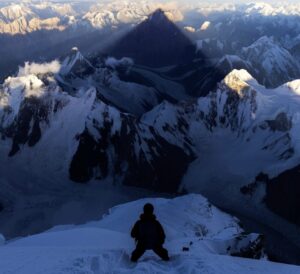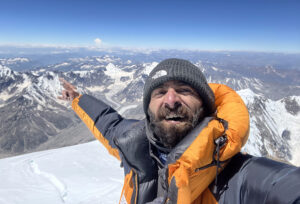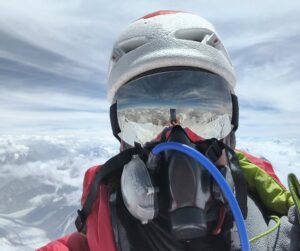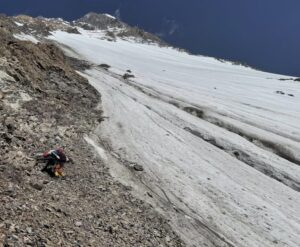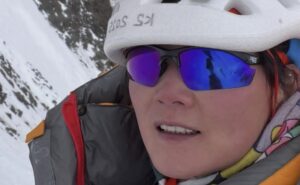The season has ended without summits on Gasherbrum II and Broad Peak, but a few climbers refuse to abandon K2. The Sherpas with Imagine Nepal are willing to lead a summit push as soon as conditions allow. Still, given the weather forecast, the chances of success are slight.
“Expeditions to 8,000’ers, especially to K2, need years of planning, training, and saving [money],” wrote Imagine Nepal’s leader Mingma G on social media. “We understand our clients’ feelings, so we don’t want to give up easily.”
The Nepalese 14×8,000m summiter says the Sherpas’ willingness to continue is keeping other climbers in Base Camp.
“The snow conditions above Camp 2 are perfect at the moment, but sadly, there is no snow below Camp 1,” Mingma G wrote.
He hopes the jet stream will move away from the mountain after hitting the upper slopes of K2 for over a week. If that happens, he is ready to “take a chance” on a summit attempt.
‘Parasites’
The typically outspoken Mingma G has accused some climbers in Base Camp of being “parasite teams.”
[They] are here without ropes and we know [what] their post [will say] if they made it to the summit: ‘No sherpa support, no oxygen, blah blah.’🤩🤩
Mingma G apparently refers to the independent climbers who pay for logistics during the trek and in Base Camp, but climb on their own, carrying their tents and gear up and down the mountain. Unless any of them climbs away from the normal route, which is not the case this year, they do use the packed trail and the ropes fixed by local and Nepalese climbers.
The debate is whether they contribute to the efforts or not.
Volunteer collaboration
On Everest, Manaslu, and Ama Dablam — the three most popular peaks in Nepal — all climbers must pay a rope-fixing fee to the Expedition Operators Association (EOA). That institution also assigns the rope fixing to specific Nepalese operators interested in managing that task. For the other peaks in Nepal with fixed ropes, local operators meet and agree who will do the job before the start of the season.
In Tibet, the CTMA (China-Tibet Mountaineering Association) is in charge of managing or assigning that work.

K2 Base Camp. Photo: Mingma G
In Pakistan, there is no such institution as the EOA to manage the rope fixing. Traditionally, the teams on a mountain will meet and agree on how to share the work among them, either by volunteering to fix ropes, providing gear, and/or paying. That has been a frequent source of conflict, but this collaboration has been essential to the expedition-style climbing on the highest peaks on Earth.
These days, independent climbers may or may not contribute, as no regulation forces them to do so. That depends on the individual climber or the personal agreement they may have with their local outfitter. Hence, the bad feelings that commercial expedition leaders have when some climbers use their ropes without providing anything in exchange.
Who’s still there?
Several climbers are on the mountain on their own or in small, non-guided groups. Mingma G mentioned no specific names or who is collaborating and who is not.
A Madison Mountaineering team, including a Western guide, Sherpa guides, and local high-altitude porters, is also there. Israfil Ashurli of Azerbaijan and Serge Hardy of France were still in Base Camp, according to their latest reports. However, it is hard to keep track, as communication is sketchy, and some climbers have just quietly left.
Discouraging forecast
Reports earlier this week suggested that a weather window might open during the first days of August. Multimodel forecasts, however, predict heavy snowfall over the next seven days, especially next Tuesday and Wednesday. Meteoexploration.com also notes high winds at summit altitude. Yet climbing teams may have more accurate information. In any case, weather predictions have consistently failed this season.
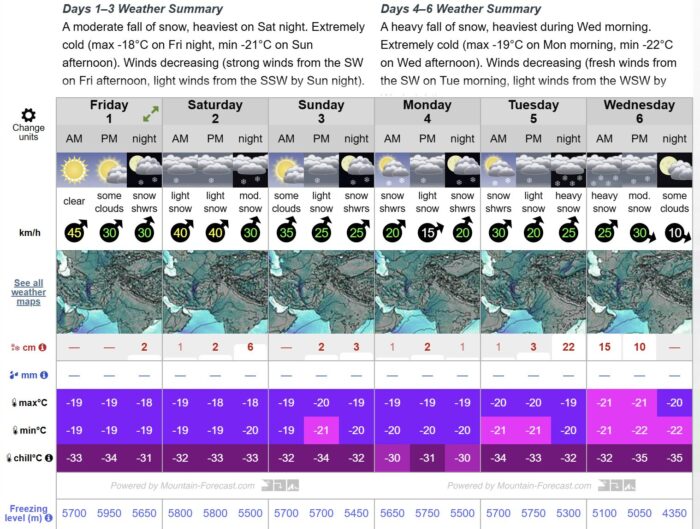
Forecast for K2 at summit altitude (8,611m) by Mountainforecast.com

Forecast for K2 at summit altitude by multimodel Meteoexploration.com

